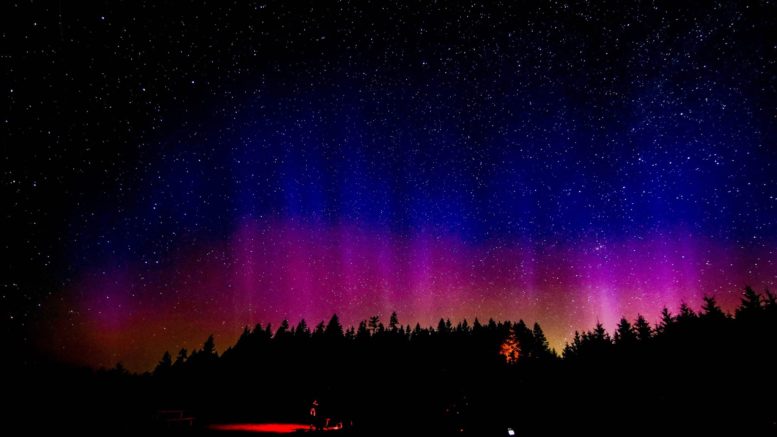A result of disturbances in the magnetosphere caused by solar wind, the Aurora Borealis is a natural light display in the Earth’s sky, predominantly seen in the high-latitude regions around the Arctic and Antarctic.
These disturbances result in the solar wind and magnetosphere plasma to be ejected from the sun. If the ejected material from the sun intersects with the orbit of the Earth, the resulting ionization and excitation of atmospheric constituents emit light of varying color and complexity. These ejections are often called CME, Coronal Mass Ejections.
The form of the aurora, occurring within bands around both polar regions, is also dependent on the amount of acceleration imparted to the precipitating particles. Other names used for Auroras include:
- northern lights (aurora borealis)
- southern lights (aurora australis)
You can see what happened when we saw the Aurora Borealis at Stub Stewart State Park in May 2018 here.

Great spots for viewing the Aurora in the Pacific Northwest includes Northern Washington and Northern Idaho where there is dark sky. Oregon will require a KP of 6+ and is best seen somewhere dark of high up, like the Vista House!
Solar Cycle
The solar cycle runs for 11 year periods, which sees the Sun’s magnetic field completely flips. This means that the Sun’s north and south poles switch places. Then it takes about another 11 years for the Sun’s north and south poles to flip back again. During that period, the magnetic field of the sun changes as do the number of sunspots as do the number of CME.
KP Index

The kp number system is just a scale of geomagnetic activity. It is not a plot map where you can definitely say auroras will be visible. The kp numbers start at 0 and as the geomagnetic strength increases, so too does the kp number. So kp 0 being a very weak or none existent aurora, right through to 9 being a major geomagnetic storm with auroras likely in France and even Northern Spain.
Worst Case Scenario
The worst case scenario is that a massive CME, coronal mass ejection, like nobody has ever seen hits Earth. This scenario would have a catastrophic effect, blowing out electrical systems, GPS, radio systems and other technology worldwide, and sending billions of people into a blackout that could have taken years to repair.
These type of events are of the type of low probability, high impact, since the result would be devastating. The most recent example is the Carrington Event, during the solar storm of 1859, which had Auroras seen around the world. Areas that could see the auroras included those in the northern hemisphere as far south as the Caribbean and those over the Rocky Mountains in the U.S. The Aurora were so bright that the glow woke gold miners, who began preparing breakfast because they thought it was morning. It has been by those who lived through the event that people in the northeastern United States could read a newspaper by the aurora’s light. An event like that in the modern world would be devastating!
Resources
https://www.gi.alaska.edu/monitors/aurora-forecast
https://www.swpc.noaa.gov/products/aurora-3-day-forecast
https://www.swpc.noaa.gov/products/aurora-30-minute-forecast

Leave a comment